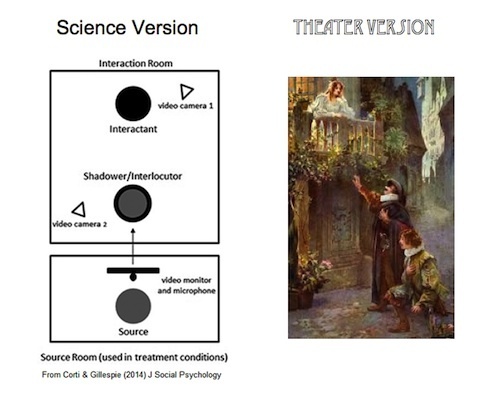If you were a meat puppet, could anyone tell?
If an alien took over your body and controlled your speech and actions, how long would it be before anyone noticed?
That’s not exactly the research question that “cyranoids” are designed to answer, but they could. Neuroskeptic reports that a couple of British psychologists, Kevin Corti and Alex Gillespie, have replicated two “cyranoid” experiments originally done by Stanley Milgram, of obedience-experiment fame.
“Cyranoid” was Milgram’s coinage–from Cyrano de Bergerac–for a person who is not speaking for or as themselves, but merely repeating words that another person is giving them. Cyrano had to hide in bushes and whisper loudly enough to be heard by Christian–and the audience–but quietly enough to be unnoticed by the fortunately rather dim Roxanne. This is all much easier with modern technology, and Corti & Gillespie were able to set up a microphone-and-monitor system that allowed Person #3 (Cyrano) to listen in on a conversation between Persons #1 and #2 (Roxanne and Christian) and feed “lines,” appropriate or inappropriate, to Christian.

Different aesthetic, same idea.
People didn’t notice, not even when Christian was a 12-year-old boy with his conversation being supplied by a 37-year-old psychologist as Cyrano. Maybe Roxanne wasn’t so dim after all.
Neuroskeptic calls this “Milgram’s creepiest experiment” and writes
If I started shadowing someone else’s speech, would my friends and family notice? I would like to think so. Most of us would like to think so. But how easy would it be? Do we really listen to each others’ words, after all, or do we just assume that because person X is speaking, they must be saying the kind of thing that person X likes to say? We’re getting into some uncomfortable territory here.
I’m not sure that much surprise is warranted, although I envy Neuroskeptic’s easy confidence that his loved ones are truly listening to him. We know people often attend more to the form than the content of other people’s speech–this is why Miss Conduct often recommends giving “placebic excuses” when ruffled feathers need to be soothed. And there’s a whole series of experiments showing that people don’t notice change in their environment. (I don’t mean “How could you not notice I changed the shelf liners, honey,” either–I mean like you’re talking to a whole ‘nother person than you started talking to, and you still don’t notice.)
More to the point, though, people aren’t going to twig to a cyranoid because cyranoids don’t exist. As Corti & Gillespie write,
It seems that when encountering an interlocutor face-to-face, people rarely question whether the “mind” and the “body” of a person are indeed unified–and for good reason, as social interaction would be undermined if we began to doubt whether each person we encountered was indeed the true author of the words they expressed.
The authors point out that people do often notice identity discrepancies “in artificial environments (e.g., Second Life and other virtual community games) wherein users can construct outer personae which starkly contrast with their real-world identities.” You don’t even need to go into immersive environments–even the comment threads on opinion blogs will tend to feature people accusing others of not really being a member of whatever group they’re attempting to speak for, or of adopting a sock-puppet identity, or the like. When we know that people’s words and being need not match up, we can be quite vigilant about clues.
I always figured that’s how Starfleet crew members managed to cotton on so quickly whenever their colleagues got possessed by the Aliens of the Week. Deanna Troi learned all the Signs of Alien Possession to watch out for when she was in psychology school, just like nowadays you learn the signs of addiction or suicide risk. I don’t even want to think how long it would take me to notice if my boss got assimilated by the Borg.
Corti & Gillespie write that people have always been fascinated by the idea of persons speaking through other persons, or different identities in the same body:
This well-known story [of Cyrano de Bergerac] is but one of the many examples of a fantasy that has appeared in the arts and mythology throughout history–that of the fusion of separate bodies and minds. Other illustrations include The Wonderful Wizard of Oz, in part the tale of a fraudster who is able to attain great power by presenting himself to the world through an intimidating artificial visage. The film Big entertains the folly that ensues when an adolescent boy awakens to find himself in the body of a middle-aged man. More recently, films such as Avatar and Surrogates have imagined hypothetical futures in which mind can be operationally detached from body, allowing individuals to operate outer personae constructed to suit their social goals. Fiction though they may be, these stories illuminate the power façade has over how we are perceived by ourselves and by others, and how we and others in turn behave in accordance with these perceptions.
Robin Abrahams's Blog



